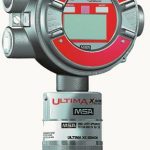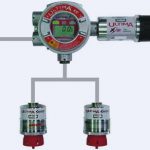Gas hazards can occur wherever oil is extracted, effluent processed or chemical products manufactured. In view of the large number of sensors now required due to the tightening up of safety legislation, manufacturers are working hard to improve gas detection devices. One example, the Ultima X series of gas monitors, demonstrates impressively the great benefits this move towards the cutting edge of gas detection technology will generate for users.
The microprocessor technology integrated in Ultima X series gas monitors makes it possible to use a single electronics module for all applications. Combustible gases are detected with catalytic or IR sensors, toxic gases or oxygen with electrochemical sensors and the same electronics module is used each time. This offers considerable advantages for the supply and inventory of spare parts while reducing training costs. Operational safety is also improved since the same procedure is used for all gases, reducing the risk of operating errors. The Ultima X series has Atex approval for Europe and UL approval for the USA. The monitors can be operated as stand-alone units or the 4…20 mA output connected to a central gas-warning control system such as the Suprema from MSA, which is especially suited to this application due to its modular design.
Key product features
Designed for use in hazardous areas, the Ultima X series is housed in a stainless steel, explosion-proof enclosure. During normal operation the large liquid crystal display alternates between sensor readings and the measured gas type being measured. The display also provides diagnostic indications, and if a malfunction is detected it changes to a scrolling text message that clearly describes the error.
Electrochemical sensors are used to detect toxic gases and oxygen, while catalytic or infrared sensors are used for combustible gases. The sensor modules are pre-calibrated prior to delivery and, with the exception of the IR sensor, they can be replaced in the field while under power even when installed in hazardous areas. This is achieved using smart technology that requires no tools to install the sensors on site. Each innovative smart sensor includes a specially designed electrical connector and electronics that are integrated into the sensor module for controlling and storing all calibration and alarm data. Catalytic and toxic sensor changes – or missing sensors – are recognised and indicated on the display as well as by the LEDs. This sensor data is further processed by the single-board electronics module in the monitor enclosure for controlling four optional relay outputs, three gas alarms and one fault alarm. All four field-programmable relay outputs can be configured to suit the application. Two large, optional quick-check LEDs are also available to indicate normal operation or an alarm or fault status. These quick-check LEDs, arranged above the display unit, provide readily visible fault and system status information at a glance, even from a distance. The Ultima X enclosure has no moving or adjustable parts such as potentiometers because all calibration and maintenance functions are performed via the non-invasive IR interface.
Simple installation and start-up
The advantages presented to users by the Ultima X series of gas monitors are even more obvious during installation, commissioning and maintenance. These gas monitors can have a two or three-wire connection, depending on the gas sensor type and the optional features fitted. Ultima X series enclosures also allow a choice of cable entry; from the top, from the left or from the right as required by the site layout. The main enclosure can be pre-installed and wired prior to fitting the main electronics module and gas sensor, thus avoiding damage to the sensor and electronics during long-term construction projects and prolonging sensor life. When the time comes for commissioning, the main electronics are simply plugged in, the factory pre-calibrated sensor fitted and power applied. If necessary, the sensor can be mounted remotely anywhere up to 30 m from the gas monitor’s main enclosure. After the unit is switched on, it performs a 30 s self-test and then automatically enters the gas measurement mode set by the user or factory. If changes are required after the order has been placed, the parameters can easily be adjusted during commissioning with the Ultima Controller, including setting the field-programmable relay outputs to the desired alarm levels.
An ideal gas monitoring system works safely and without errors until it signals that it needs to be maintained, preferably not too often. The Ultima X series sensors automatically compensate for temperature and humidity variations and the compact, robust design with state-of-the-art technology results in minimal susceptibility to failure. Continuous self-tests determine the remaining sensor life and when this life falls below a pre-determined value, a signal that the sensor needs replacing appears on the LCD. The sensors can either be replaced as delivered (pre-calibrated) or they can be calibrated in the field. All sensors other than the IR sensor can be replaced under power.
Operation via IR interface
Two types of remote control module are available and both have a non-invasive IR interface for communicating with the Ultima X gas monitor. The intrinsically safe Ultima Calibrator, with its simple three-button operation, is used for zero and span calibration and to change the monitor address. Alarm suppression and an output signal delay can be activated to avoid alarms during these tasks. The intrinsically safe controller with display and keyboard allows password-protected access to all calibration, adjustment and maintenance tasks via the display. These include displaying and setting alarm levels, relay operation and span gas values as well as minimum, maximum and average gas readings.
Up to three sensors per monitor
The most recent addition to this family of gas monitors is the Ultima X3, which combines all the benefits of the Ultima X series and is also capable of digital communication. A maximum of 31 monitors can be connected to the same line via an industry-standard Modbus RTU or linked up to a PLC or DCS. One distinct advantage of the Ultima X3 is that each unit can be fitted with up to three sensors, so that a total of 93 sensors can share a single signal line. It is capable of using all three available sensor technologies (catalytic, electrochemical and infrared), allowing greater flexibility. The X3 gas monitor’s scrolling display shows the gas reading and type of all fitted sensors. For Modbus digital communication, the X3 monitor operates as a slave device on the network and remotely installed sensors can be arranged up to 60 m apart. Internal relays can be configured for three different common alarms or one single alarm per sensor and digital communication facilitates remote diagnostics.
Hall 4.1, Booth N15
cpp 437
More information on the detectors
Expo Protection Feu
Achema 2006
Share:









